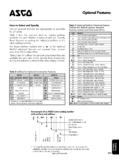Transcription of White Paper: Key Features of the DeltaV PID Function Block
1 DeltaV Distributed Control SystemWhite PaperOctober 2016 Key Features of the DeltaV PID Function BlockThis White paper highlights several Features of the DeltaV PID Function that were not historically found in other PID Function Features of the DeltaV PID Function BlockOctober of ContentsIntroduction ..Dynamic Reset and Standard Degrees of Tuning for Positional Control Setpoint Filter ..334568 Key Features of the DeltaV PID Function BlockOctober PID Function Block provided in the DeltaV system provides several Features not historically found in other PID Function Reset LimitingDynamic reset limiting provides dynamic compensation of integral accumulation based on output response achieved.
2 If the PID outputs to the field, then output to the field provides the measure of output response. If the PID is a master in a cascade, then the PV of the slave can be used as the measurement of output response. This method provides appropriate behavior in override applications as well as providing a stabilizing effect on cascade performance of a slave in a cascade will often deteriorate as process conditions change. In that case the response of the master will be affected. As illustrated in the following plot, dynamic reset limiting significantly compensates for the deterioration of slave 1 Dynamic reset Features of the DeltaV PID Function BlockOctober and Standard ExecutionEnd-user s application and maintenance groups, who usually cite simpler tuning as a reason for the preference, very often prefer the Series form.
3 However, there are cases, such as underdamped processes for which the Series form produces unacceptable results. In those cases, the DeltaV user may simply switch to standard execution to achieve the tuning range necessary. Standard or Series operation is selected with the parameter the following plot, a standard form DeltaV PID controls an underdamped open loop process. The open loop response (response to an output change, while the PID is in manual operation) is oscillatory, but by proper tuning of the standard form PID, the closed loop response exhibits little overshoot and ringing; this cannot be done with a series form 2 Underdamped process Features of the DeltaV PID Function BlockOctober Degrees of FreedomOften when tuning a control loop for disturbance rejection the setpoint response will exhibit considerable overshoot.
4 This is particularly true when there is derivative action required and the derivative action is taken only on PV (too avoid large bumps in output as the result of modest setpoint changes). Two Degrees Of Freedom structure, provided by DeltaV , allows shaping the setpoint response by adjusting the proportional and derivative action applied to setpoint; the adjustment parameters are BETA (for proportional) and GAMMA (for derivative); tuning range is from no action to full action (0 1); Two Degrees Of Freedom is selected with the parameter STRUCTURE. The following plot illustrates the setpoint response for a loop tuned for good disturbance rejection with little or no overshoot in the disturbance response.
5 As can be seen, adjustment of BETA and GAMMA can significantly reshape the setpoint response and drastically reduce the overshoot from that of a PID that has full proportional and no derivative action on 3 Use of BETA and GAMMA to shape SP Features of the DeltaV PID Function BlockOctober Tuning for Positional Control AlgorithmThe DeltaV PID Function Block provides positional behavior for setpoint and process variable, which makes it suitable for proportional plus derivative structures with no integral action. Unlike most positional PID algorithms, the DeltaV PID Function Block also provides bumpless tuning parameter entry for both Series and Standard following plot demonstrates the positional behavior and bumpless tuning for proportional only structure (selected as a proportional plus derivative structure via the parameter STRUCTURE, tuned with RATE=0).
6 Starting with a bias of 50 and setpoint and process variable aligned at 50, a load change of 20 % is introduced. Then after the loop has stabilized, GAIN is changed from 2 to 4. The effect of the gain change on the output is introduced at the reset time constant, which is set through RESET, even when STRUCTURE selects a non-integrating control type. By setting RESET=0, the gain change effect will be 4 Bumpless gain entry with static error-proportional only Features of the DeltaV PID Function BlockOctober the following plot tuning parameter entries are made when the process is in a dynamic state. Starting with process variable moving toward setpoint RATE is changed from 1 to 5; the change is felt at the output at the reset time constant ( RESET ) which in this case is 10.
7 While the RATE change is still being filtered in, an additional process rate of change is introduced; the effect of the process rate of change on derivative output is immediate using the full RATE tuning constant previously entered. This demonstrates that while the tuning parameter change is filtered in at the reset time constant, the derivative and proportional action on setpoint and process variable will not be affected but will always apply the current parameter values to setpoint and process 5 Tuning parameter changes while process Features of the DeltaV PID Function BlockOctober Setpoint FilterThe setpoint filter (set with parameter SP_FTIME) is a tuning as well as setpoint shaping feature .
8 SP_FTIME can be used to minimize output kick on large setpoint changes or to reduce overshoot when a control loop is tuned for disturbance rejection (often resulting in overshoot on setpoint changes). The following plot demonstrates the effectiveness of setpoint filtering in reducing 6 SP Features of the DeltaV PID Function BlockOctober 2016 EmersonNorth America, Latin America: +1 800 833 8314 or +1 512 832 3774 Asia Pacific: 65 6777 8211 Europe, Middle East: +41 41 768 6111 2016, Emerson Process Management. All rights Emerson logo is a trademark and service mark of Emerson Electric Co. The DeltaV logo is a mark of one of the Emerson Process Management family of companies.
9 All other marks are the property of their respective contents of this publication are presented for informational purposes only, and while every effort has been made to ensure their accuracy, they are not to be construed as warranties or guarantees, express or implied, regarding the products or services described herein or their use or applicability. All sales are governed by our terms and conditions, which are available on request. We reserve the right to modify or improve the designs or specifications of our products at any time without notice.


















